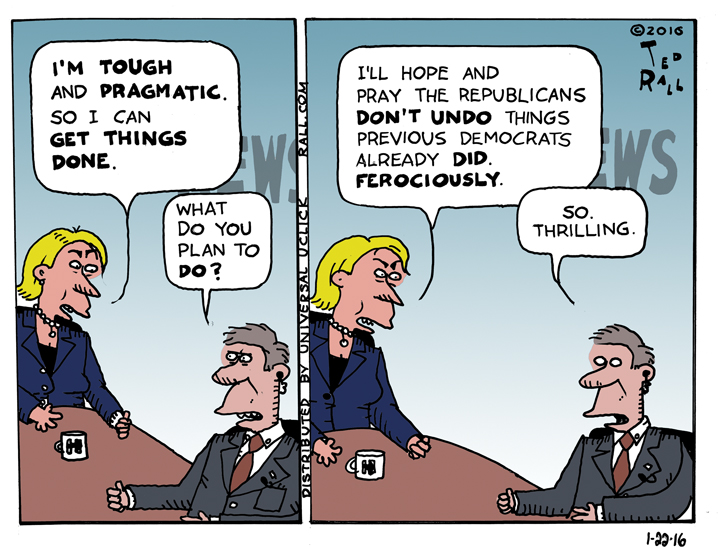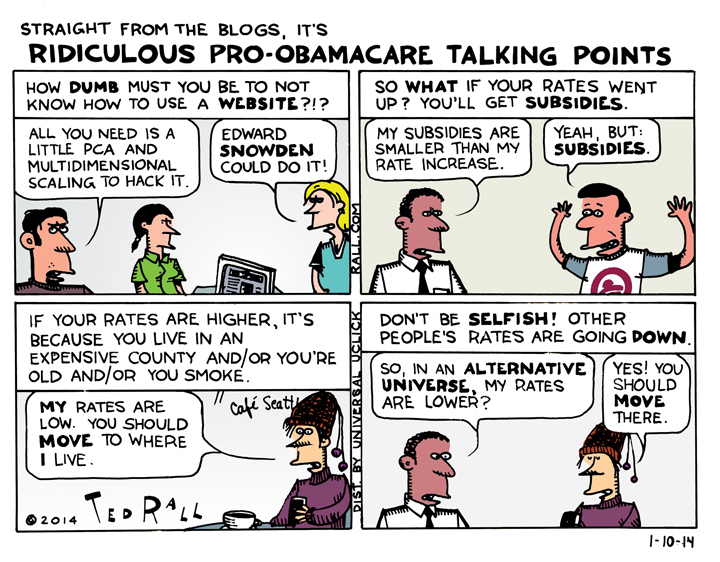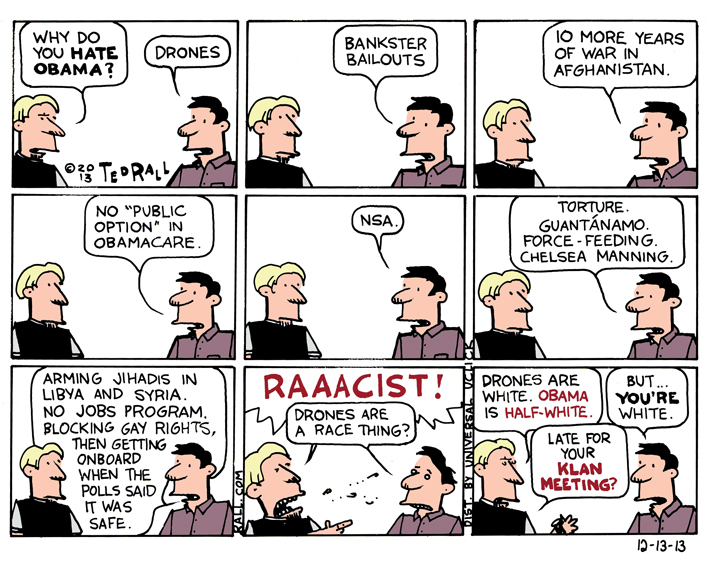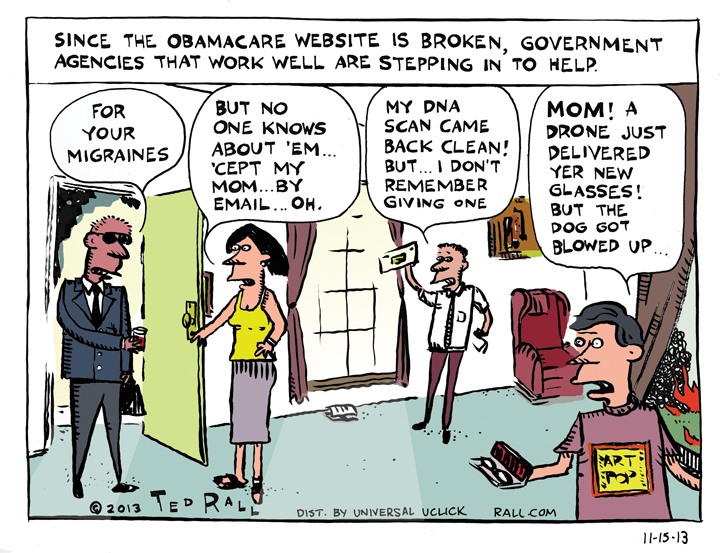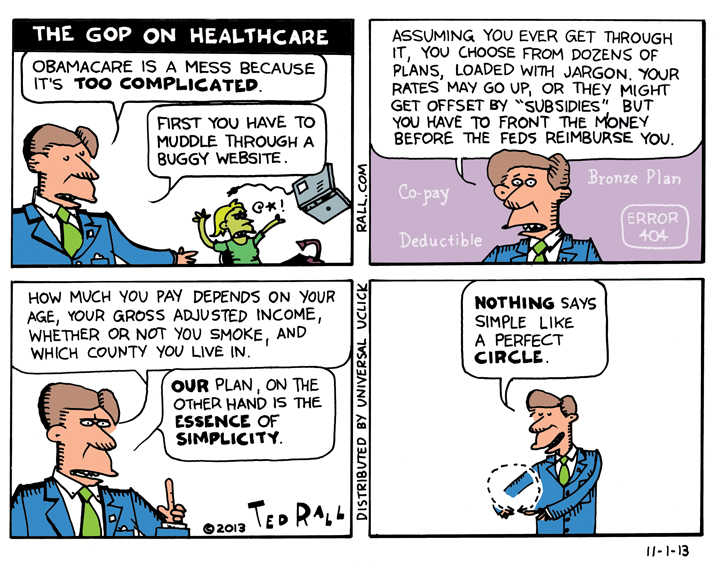Confronted with an optimistic opponent who promises substantial changes in American foreign and domestic policy in the form of Bernie Sanders, establishment candidate Hillary Clinton has been reduced to promising incremental improvements, and defending past gains. She argues her approach is more pragmatic. But will voters be satisfied with more of the same?
SYNDICATED COLUMN: Healthcare Insurance Pigs Soaking Americans With Secret 20%-40% Rate Increases on Obamacare

This is what happens when you trust free markets.
You probably heard that the Supreme Court rejected the latest legal challenge to the Affordable Care Act, a.k.a. Obamacare, a.k.a. The Great Transfer of Taxpayer Dollars to Scumbag Health Insurance Companies. That news broke during a major news day.
What you likely missed, because it came out on July 3rd when everyone was driving to the beach or flying somewhere fun for their Independence Day weekend getaways instead of paying attention to the news, was that the ACA is tanking. That’s why you have me: to read depressing tidbits about America’s decline, and to annoy Obamabots with another I-told-you-so.
When Obama resurrected 1993’s benighted Hillarycare scheme, I warned that there were two major problems with this convoluted hybrid of government-managed healthcare and for-profit healthcare.
First, the Affordable Care Act kept the insurance companies in business. Aetna, United Healthcare and the other big insurers are a huge drain on the system, sucking out billions in profits and driving up costs. Profitmaking has no place in healthcare, which is a basic human right, like air and water. Air and water are free; healthcare should be free too. But that’s the opposite of what drives health insurers: they want to give you as little care as possible while charging you as much as possible.
Second, the ACA diminished Americans’ zeal for socialized medicine, the standard in the developed world. “In legislation no bread is often better than half a loaf,” Robert La Follette, the Wisconsin Progressive of the late 19th and early 20th centuries, pointed out. “Half a loaf, as a rule, dulls the appetite, and destroys the keenness of interest in attaining the full loaf.” I wrote last year: “In 2007, before Obama and his ACA came along, 54% of Americans favored single-payer. Now, thanks to a system that’s better than nothing but not nearly good enough, it’s down to 37%. Hillary Clinton is endorsing Obamacare, and has officially come out against single-payer.”
Now that the public has had a chance to use and pay for Obamacare, support for single-payer is back up to 50%.
Back to that story that broke on the deadest news day of the year. From The New York Times: “Health insurance companies around the country are seeking rate increases of 20% to 40% or more, saying their new customers under the Affordable Care Act turned out to be sicker than expected…Blue Cross and Blue Shield plans — market leaders in many states — are seeking rate increases that average 23 percent in Illinois, 25 percent in North Carolina, 31 percent in Oklahoma, 36 percent in Tennessee and 54 percent in Minnesota, according to documents posted online by the federal government and state insurance commissioners and interviews with insurance executives.”
Did your paycheck go up 20%, much less 40%, in the last year? I didn’t think so.
The proper reaction to this disgusting move — remember, we’re talking about a for-profit corporate sector that rakes in billions of dollars a month and pays its CEOs millions of dollars a year — is to line up the executives responsible against a wall and shoot them full of holes, then deny the healthcare claims of any who survive just because, as the rest of us routinely experience.
Since that would be illegal, however, the second-best approach should be to shame the bastards relentlessly on social media, until they’re forced to go join ISIS because people would subject them to Two Minute Hates wherever they go. (Not to say that ISIS, which provides free healthcare, would want these human turds either.)
This is where one naturally turns to political leadership. Surely the President of the United States, a.k.a. He For Whom Obamacare Is Named, will crack down on these insurance pirates?
Not so much. Obama “said that consumers should put pressure on state insurance regulators to scrutinize the proposed rate increases. If commissioners do their job and actively review rates, he said, ‘my expectation is that they’ll come in significantly lower than what’s being requested.'”
No doubt the healthcare industry itself, which rakes in billions each year from their new involuntary customers, hears our anger.
Not so much. Marinan Williams, CEO of the Scott & White Health Plan in Texas, which applied for a 32% rate hike, says: “Over the next three years, I hope, rates will start to stabilize.” How about we “stabilize” her salary at 32% less than she gets now?
How’s your interest in the “full loaf” — single-payer socialized medicine — now?
(Ted Rall, syndicated writer and the cartoonist for The Los Angeles Times, is the author of the book “Snowden,” the first biography of NSA whistleblower Edward J. Snowden. It is in graphic novel form, and will publish August 18th. You can subscribe to Ted Rall at Beacon.)
COPYRIGHT 2015 TED RALL, DISTRIBUTED BY CREATORS.COM
SYNDICATED COLUMN: Still No National Healthcare For Mental Illness? That’s Crazy

TED RALL
STILL NO NATIONAL HEALTHCARE FOR MENTAL ILLNESS? THAT’S CRAZY
BY TED RALL
RELEASE: WEDNESDAY, DECEMBER 24, 2014
The sister of the 28-year-old man who shot his ex-girlfriend in Baltimore the same morning he killed two New York police officers as they sat in their patrol car in Brooklyn said her brother had long suffered from mental illness, but hadn’t received treatment.
“He was an emotionally troubled young man, and he was suicidal,” said Jalaa’i Brinsley. “Clearly something’s wrong. He should have been offered help in the system, right? But he wasn’t.”
Indeed. Something is very wrong.
In the United States, psychiatric care is a luxury that, at $150 an hour and up for counseling that can last for months or even years, only the very wealthiest citizens can afford.
This latest sorry episode serves as yet another reminder that ours remains a country in its infancy when it comes to health care, despite the undeniable turning point marked by last year’s enactment of the Affordable Care Act. As many as one out of four Americans suffer mental health issues in any given year, yet even upper-middle-class “white-collar” workers with relatively high-end health insurance plans receive little coverage for mental illness. The same goes for dental and vision care.
You know the narrative by now: after a particularly heinous shooting or mass shooting, typically ending with the suicide or death-by-cop of the suspect, relatives of the murderer emerge to express their sorrow and anger that they had repeatedly sought help but had been consistently rejected, usually due to their inability to afford expensive treatment and medications for mental illness. For the most part, however, news coverage and political debate emphasizes helplessness – who can predict who will go crazy? – and America’s easy access to high-powered weapons. Sure, there is a flutter of discussion of the fact that few Americans have access to care for mental illness, but those stories are inevitably overshadowed by the gun control and the “culture of violence” chatter.
Talk about crazy!
As the bodies of the victims – which, if you are fair-minded, must include the killers along with the killed – go cold in their graves, the media and thus the population at large move on, the system putters on the same as always, denying countless millions access to the mental health professionals this country can easily afford to pay on their behalf, and setting the stage for some tiny fraction of them to go haywire and commit the headline-grabbing mass murders of the future.
Two years ago, after Adam Lanza slaughtered 20 children and six staffers at Sandy Hook Elementary School in Newtown, Connecticut, killed his mother and himself, some public officials declared that it was time to get serious about mental illness. According to a report by the Connecticut Office of the Child Advocate, Lanza had never received treatment for years of mental illness, including anxiety, depression and obsessive-compulsive disorder.
But, as USA Today reports, “the drive for change has [since] slowed at the state level and ground almost to a halt in Washington…Only 29 states increased funding this year, however. Seven states reduced mental health spending. In some states, mental health funding is still less than it was before the [2008-10] recession.”
“We’re seeing less attention to mental health, and that’s concerning to us, because we’re still seeing so many tragedies every day,” Mary Giliberti of the National Alliance on Mental Illness (NAMI) told the paper. Although individual tragedies may not make the news, she said, “the suffering is tremendous when people don’t get the services they need. People end up in emergency rooms. People end up in jails and prisons, which is absolutely the wrong place for someone with mental illness.”
Mental illness is one of America’s biggest hidden scourges.
According to NAMI, 1 in 17 adults − about 13.6 million Americans – suffer from a serious mental illness, such as schizophrenia, major depression or bipolar disorder.
46% of homeless Americans in shelters suffer from serious mental illness and/or substance abuse.
20% of prisoners in state and local prisons have a recent history of mental health problems.
70% of children in juvenile prisons have a mental health condition.
People need help, but they’re not getting it. 60% of adults with mental illness received no treatment within the last year.
Mental health treatment is expensive — but so is ignoring the problem. “Serious mental illness cost the economy $193.2 billion in lost earnings each year,” according to NAMI. Think of all the wars we could fight with the taxes from those lost salaries! Or don’t: 22 veterans commit suicide daily.
This year is a perfect example of the system’s inability and/or unwillingness to respond to the mental health crisis. Even after actor-comedian Robin Williams succumbed to suicide after years of alcoholism and depression, and a severely depressed 22-year-old man killed six people and then himself at the University of California at Santa Barbara, you couldn’t even find a single liberal Democrat in either the House of Representatives or the Senate to propose a bill that would expand the ACA to include comprehensive coverage for mental illness.
Santa Barbara shooter Elliot Rodger’s “parents repeatedly attempted to get psychiatric help for their son. By his own account, he was prescribed antipsychotic medication but refused to take it,” CBS News reported at the time.
There is a strong argument to be made in favor of restricting access to the highest powered automatic weapons, as well as philosophical interest in debating the nature of good and evil, but if we as a country truly want to reduce the frequency and severity of shootings in our public spaces, we should start by throwing some serious money at psychologists and psychiatrists.
“About half of these mass killings are being done by people with severe mental illness, mostly schizophrenia,” Dr. E. Fuller Torrey, a leading expert on severe mental illness told “60 Minutes” in 2013. “And if they were being treated, they would’ve been preventable.”
So it wasn’t just “evil,” or random criminality, that killed those two NYPD officers last weekend.
It was us.
(Ted Rall, syndicated writer and cartoonist, is the author of the new critically-acclaimed book “After We Kill You, We Will Welcome You Back As Honored Guests: Unembedded in Afghanistan.” Subscribe to Ted Rall at Beacon.)
COPYRIGHT 2014 TED RALL, DISTRIBUTED BY CREATORS.COM
SYNDICATED COLUMN: What Would President Hillary Do? She’ll Be the First Woman President.
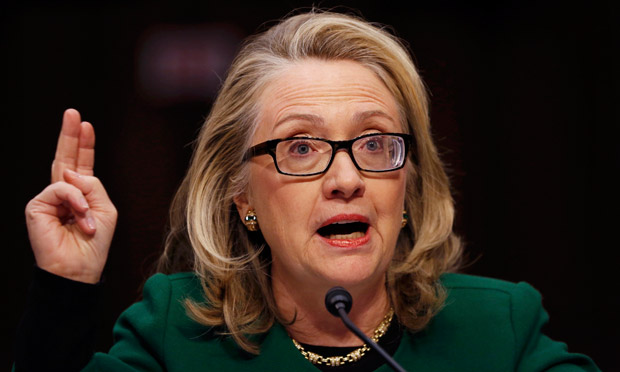
Hillary is the talk of 2016. Will she run? According to the pundit class whose water cooler speculation gets repackaged as “conventional wisdom,” the nomination is the former First Lady’s for the asking. Following a coronation that saves her cash and bruising primary battles, it’s currently hard to conjure a Republican who can stop her from taking the general election too.
But to paraphrase a recent viral music video, there’s one thing that no one knows:
What would President Clinton II do?
I posed this question to “Ready for Hillary,” the main pro-Hillary Super PAC. “Ready for Hillary focuses on grassroots organizing, not policy,” replied Seth Bringman. “Policy decisions would be up to the campaign if Hillary runs, which we are certainly encouraging her to do. We amplify the causes Hillary is advocating for and spread the word to our more than one-and-a-half million supporters. We have done so when Hillary spoke out on immigration reform, health care, voting rights, unemployment insurance, and the government shutdown.”
Given that the pre-primary season doesn’t begin for another 18 months, it’s a little early to expect a fully fleshed-out policy platform from a probable candidate. But HRC isn’t a fresh young thing. She’s been kicking around politics for decades — so it’s more than a little strange that neither her fans nor her enemies has a clue what she’d do about a host of issues.
Long before 2000, Al Gore’s longstanding interest in climate change signaled that the environment would have been a priority in his administration. Beginning with his testimony in the 1971 Winter Soldier hearings, John Kerry’s career path predicted a preference for diplomacy over war. On the other hand, it was similarly clear long before 2008 that a John McCain Administration would have been belligerent and quirky, featuring occasional alliances of convenience with Democrats.
So, what about Hill? The only agenda item anyone could have reasonably predicted was a revival of HillaryCare — which is now basically Obamacare. The biggest arrow in her quiver is gone.
Ready for Hillary says it has raised $4 million from 33,000 donors during 2013. That’s a lot of money. You’d think the donors would know what they’re buying, but if that’s the case, they’re keeping it to themselves.
Hillary leads every poll of the Democratic field for 2016. But why? What is it about her that makes some liberal voters swoon?
I combed the Internet looking for signs of something approximating a political agenda. I pushed out the following question to social networks: “Support Hillary for 2016? Can you tell me what she would DO?”
The closest approximation to an answer came back: “She would be the first woman president.”
Yeah, we knew that — but would she be a first woman president who fires drones at wedding parties, or a first woman president who pushes for a $20/hour minimum wage, or a first woman president who continues the first black president’s policy of not using government to try to create jobs? Would she be a first woman president who closes Guantánamo? Would she be a first woman president who continued NSA spying on Americans? Would she be a first woman president who adds a public option to the Affordable Care Act?
As far as I can tell, the (Democratic) arguments for Hillary boil down to the following talking points:
- Unlike Obama, who let himself get rolled by the Republicans, Hillary is tough and battle-tested. She’s a good negotiator.
- She’s an experienced manager. “Ready on day one,” she argued in 2008. She knows everyone and everything in government.
- Like her husband, she’s somewhat more liberal than Obama.
- She’s pre-disastered, thus electable. If there were any more Travelgates, Whitewaters, etc., the media would have uncovered them by now.
These are personality traits, not prescriptions for America.
Hillary Clinton isn’t a candidate — she’s a brand. She doesn’t offer a set of ideas; she projects a vague sense of competence that feels absent in the current White House. (Didn’t she used to hold some kind of big job in that place?) Despite having held high posts in government, she can’t point to a single major legislative or ideological achievement — but that doesn’t matter to her supporters.
Mostly, Hillary represents the potentiality of a historical symbol: first woman president. As soon as she takes the oath of office, her campaign’s biggest goal, shattering the ultimate political glass ceiling, will have been achieved.
If this feels familiar, it should. Senator Barack Obama was Clinton in 2006 and 2007, projecting calm after long post-9/11 years of jittery Bushisms, with a light resume that served as a blank slate, allowing people to project their hopes and ideals upon him. In the end, all that mattered was the beginning: winning as a black man. For the Obamabots, all that followed — protecting Bush’s torturers, the bankster bailouts, the drones, the NSA — was beside the point of their politics of identitarian symbolism.
What will happen to the long-term unemployed under Hillary? If 2008 serves as a guide, the 2016 campaign will pass without Americans much talking or thinking about such questions.
(Support independent journalism and political commentary. Subscribe to Ted Rall at Beacon.)
COPYRIGHT 2014 TED RALL, DISTRIBUTED BY CREATORS.COM
SYNDICATED COLUMN: Saving Private Healthcare
Socialized Medicine Would Be Better Than Obamacare. In the Meantime, Let’s Waste Some Time on Some Lame, Doomed Reforms.
Anyone who has tried to sign up for Obamacare, as I have, knows that the launch of the Affordable Care Act has been — is — an unmitigated disaster.
Can it be fixed? Maybe.
But first, it’s important to digest the sheer ginormousness of this bastard cross between privatized grift — a wholesale transfer of wealth from individual patients to giant insurers subject to no oversight but their own absent consciences — and a spectacularly inept government bureaucracy run by careless, corrupt, connected buffoons.
More than 2 million people are getting booted from their existing health insurance because their current plans fall short of ACA standards.
Obama’s defenders say the cancelled coverage was “junk quality.” Which may be true. Still, it might have been nice to tell people about this provision, which the White House was well aware of, three years ago. When the president signed the law. As opposed to, you know, assuring us of the exact opposite.
Back in 2010, it turns out, the feds estimated that 50% to 75% of all current individual policies would have to be cancelled due to the ACA. So the current crisis is likely to expand in scope.
There’s no evidence that anyone has successfully purchased a plan. None. No one. Zero.
Six people managed to “sign up” on October 1st. Nationally.
As for the “signs-ups” — people who managed to register online or by phone, but couldn’t choose or sign up for an actual plan — it turns out that 90% of these people are so poor that they’ll get Medicaid. Only 10% might wind up buying the mandated private insurance plans. “When we first saw the numbers, everyone’s eyes kind of bugged out,” Matt Salo, head of the National Association of Medicaid Directors, told The Washington Post. “Of the people walking through the door, 90 percent are on Medicaid. We’re thinking, what planet is this happening on?”
Seriously?
The United States is not a rich country — well, it’s rich, but most United Statesers are poor. And anyway, who do you think is going to jam up the Intertubes to get healthcare first, 23-year-old “young invincibles” earning $10 an hour, or 53-year-old diabetics?
There may well be fewer Americans covered by insurance on New Year’s Day 2014 than on 2013 — due to Obamacare.
It’s been estimated that 45,000 Americans die each year because they’re uninsured. In other words, according to back-of-the-envelope arithmetic, 3,800 people will die because Obama and his underlings didn’t focus on the website launches until a couple of weeks before October 1st. Those are Katrina numbers. With more victims by the day.
I’m not counting those who will lose their existing plans without being able to replace them.
OK, it’s easy to complain (than to sign up for Obamacare, bapadumbum). What would I do differently?
Socialized medicine. Like in England. It works.
But an intelligent, pro-human solution is not in the cards. Not in bankster-owned America. Not now, anyway. Both the Democrats and Republicans are owned by the big corporate insurers that stand to make billions from the Affordable Care Act. Before the country, and eventually its political class, get real and get serious, we’ll have to waste a few years on attempts at reform.
If I were advising President Obama, here’s what I’d tell him to do:
Simplify the pricing structure. The current system’s complexity didn’t develop organically. It’s a feature. Deductibles and partial co-pays are hidden extra fees, like baggage fees charged by airlines. A plan that charges $7000 a year, but has a $3000 deductible, should be sold as a $10000 plan. Sticker shock is good. It encourages competition.
Price controls. Letting insurers charge whatever they want is ridiculous. The Department of Health and Human Services should set prices of everything from tests to drugs to visits to operations. They should squeeze the insurers to a reasonable, rock-bottom profit margin.
Eliminate sleazy out-of-network structures. Every plan should cover every doctor, every hospital, every drug. Americans shouldn’t have to live in a world where they can get a procedure at their in-plan hospital only to be told later — via a surprise bill — that the anesthesiologist, who works at the hospital, isn’t affiliated with it.
Suspend the stick, leave the carrot. The tax on Americans who can’t afford to buy for-profit insurance is unfair and cruel to working-class Americans — those who can least afford either the coverage or the fines.
Make it a national system. Rates vary wildly, not just between states, but even by county. We’re one nation. Let’s pool our resources as well as our risks. Under Obamacare as it stands, people who live in rural areas pay the highest rates — even though average salaries are lower away from big cities.
Whether these reforms fail in Congressional debate due to insurance company lobbyists or get enacted but don’t do enough to fix the system, they’ll get us closer to what we really need: a single-payer system. You know, like the rest of the First World has.
(Ted Rall’s website is tedrall.com. Go there to join the Ted Rall Subscription Service and receive all of Ted’s cartoons and columns by email.)
COPYRIGHT 2013 TED RALL
Obamacare Update
Four consecutive weeks of Obamacare columns is enough to make anyone sick. But an update is clearly in order.
The latest ACA-related fiasco is the story, much touted by Republicans, that millions of Americans are receiving cancellation notices from their insurers because their policies don’t meet the requirements of ACA for coverage. Between that and the fact that it’s basically impossible to buy a healthcare plan online (you can register, but registration isn’t buying), it is entirely possible that by January 1st there will be more people uninsured than before.
Granted, Republicans don’t enjoy any credibility when it comes to healthcare. After all, their solution was none at all. They were fine with the current, crappy, who-cares-if-you-die system. But that doesn’t mean the ACA is an improvement.
And if Democrats keep spouting talking points like the one I saw all over MSNBC yesterday, encapsulated perfectly by this post, which I found on Daily Kos this morning, they shan’t long have any cred left themselves:
They are trash policies that would have left policy-holders paying thousands out of their own pockets at time of claims. Non-guaranteed renewable, limited in benefit coverage, no preventive care, and most have absolutely no drug coverage. The maximum limit of coverage, which is a lifetime maximum, and is soon reached in this day and age.
The insurance companies issuing these policies knew they had three years to comply with the mandates of the Affordable Care Act, and they decided this was the way to get rid of that line of business, and rack up more premiums on better plans. The small percentage of people whose policies are being canceled should really thank God that it is forcing them to re-look at what they have in the way of health care. Most don’t even know they had inferior policies they were paying for.
Let’s bring this country of under-insureds up to normal and reasonable limits for the 21st century.
The thing is, Democrats, President Obama didn’t tell the public “If you like your current plan, you can keep it unless it doesn’t meet the new standards.” There was no qualifier. Instead he said, over and over, so often that even Americans remember, “If you like your current plan, you can keep it.” The qualifier matters.
Democrats are whistling past the graveyard if they think this doesn’t matter. Getting a cancellation letter is a major pain in the ass. People who thought they were fine and didn’t have to worry about the ACA now have to break their routines, take hours out of their lives, to deal with shopping for new coverage. They’re not going to be happy about it, no matter how much they’re told their old plan was shitty and worthless in the first place.
Sure, I’d rather drive a Dodge Challenger than a Honda Civic. But what Obama is doing is pulling me over, towing away my Civic and telling me I’ll be fined — and have to walk home — unless I buy a Challenger that I may or may not be able to afford. That’s pretty bad, but the last thing he’d better add is that he’s doing me a favor.
So in other news, I received a letter from nystateofhealth, the New York state ACA marketplace. A letter. Via snail mail. Good news! “We have determined that you are eligible to enroll in a qualified health plan through the Marketplace,” it reads. “Your health insurance plan will begin shortly after you have selected a health plan and paid the premium payment (if applicable).
I went online right away to log in. But…
All my personal data, all the information I spent hours uploading, including three months of personal financial statements related to my self-employment business as a cartoonist and writer, were gone!
So I got on the phone. The phone mail tree is byzantine but eventually a person picked up, accessed my account, and confirmed that indeed, I do qualify for coverage. “Can I choose a plan through you?” I asked the agent.
“No,” he replied, “you’ll get a letter, probably in early December. Go ahead and disregard the one you received.”
Really? Disregard it? What will the second letter say?
“You’ll be able to choose the plan through the letter,” he said. Twice, because I made him.
“Through the mail?”
“Yes. Then your plan will be effective January 1st.”
Let’s hope this is true. And that it works.
Even so, I wonder: why’d they bother with the websites in the first place? Why didn’t they just do the whole thing by mail?
I’ll let you know what happens. Or doesn’t.

